Synthesis and Characterization of Cobalt and Nitrogen Co-Doped Peat-Derived Carbon Catalysts for Oxygen Reduction in Acidic Media
Abstract
:1. Introduction
2. Peat-Derived Carbons and NPGM Catalysts Preparation
2.1. Synthesis of Peat-Derived Carbons
- (1)
- (2)
- Using a direct activation method, the dry peat was mechanically mixed together with reactants (either KOH (prepared from 99.99% KOH pellets, Sigma-Aldrich, St. Louis, MO, USA) or ZnCl2 (anhydrous, free-flowing, Redi-Dri™, reagent grade, ≥98% Sigma-Aldrich, St. Louis, MO, USA)) and pyrolyzed in a flow of Ar for 2 h at 700 °C. The received carbons were marked with the abbreviations: C-2(KOH) and C-2(ZnCl2), respectively [9,24,25,26].
- (3)
- The pre-treated peat was pre-pyrolyzed in a flow of Ar at 450 °C for 3 h. After that, a washing procedure was performed using 20 wt% KOH and then 50 wt% HCl solution. The obtained mixture was washed with Milli-Q® water, dried, and named C-3. A fifth material (C-3(pyr)) was prepared using a post-pyrolysis in Ar at 1000 °C for 2 h [10,24].
2.2. Preparation of Cobalt and Nitrogen Co-Doped Catalysts
3. Physical and Electrochemical Characterization Methods
3.1. Physical Characterization Methods
- High-resolution scanning electron microscopy (HR-SEM) measurements were conducted with a Zeiss Merlin microscope(ZEISS, Oberkochen, Germany). For HR-SEM studies, the samples were placed on a copper sample holder. The composition of the materials was analyzed by energy-dispersive X-ray spectroscopy (EDX) on an HR-SEM Zeiss Merlin equipped with a Bruker EDX-XFlash® 6/30 detector (Bruker, Billerica, MA, USA) with an accelerating voltage of 8 kV. The elemental composition of the materials was determined using P/B-ZAF standardless mode.
- X-ray diffraction (XRD) patterns of the synthesized catalysts were recorded using a Bruker D8 Advanced diffractometer (Bruker, Billerica, MA, USA) equipped with a Ni-filtered CuK radiation source (λ = 1.5406 Å). Topas software (v6, Bruker, Billerica, MA, USA, 2019) was used for data analysis.
- High-resolution transmission electron microscopy (HR-TEM) analysis was performed with a JEOL JEM-2100 (JEOL, Tokyo, Japan) device at a working voltage of 200 kV.
- X-ray photoelectron spectroscopy (XPS) was used to determine the surface elemental composition of the Co-N/PDC catalysts. The measurements were carried out using a SCIENTA SES 100 spectrometer (SCIENTA, Uppsala, Sweden) with a non-monochromatic twin anode X-ray tube (Thermo XR3E2 (Thermo Fisher Scientific, Waltham, MA, USA)). Casa XPS software (v2.3.24, Casa Software, Tokyo, Japan, 2020) was applied to analyze the N1s and C1s spectra [27].
- The specific surface areas (SBET) and pore size distributions were analyzed with the low-temperature nitrogen sorption method using an ASAP 2020 device (Micromeritics, Norcross, GA, USA). The SBET values were calculated using the Brunauer–Emmett–Teller (BET) multipoint theory. The specific surface area (SDFT), total pore volume (VDFT), and pore size distribution curves were calculated from N2 gas sorption isotherms by applying 2D-NLDFT theory using SAIEUS (v3.0, Micromeritics, Norcross, GA, USA, 2020) software [9,28,29,30].
- Raman spectroscopy was applied to characterize the graphitization degree of the PDCs and Co-N/PDCs. Raman spectra were recorded using a Renishaw inVia Raman spectrometer (Renishaw, West Dundee, IL, USA) with a 514 nm laser line. OriginPro 2016 software (v2016, Originlab, Northampton, MA, USA, 2016) was used for data analysis [31].
3.2. Electrochemical Characterization
3.3. PEMFC Measurements
4. Results and Discussion
4.1. Physical Characterization of Materials
4.2. ORR Analysis by RDE
4.3. PEMFC Analysis
5. Conclusions
Author Contributions
Funding
Acknowledgments
Conflicts of Interest
References
- Gröger, O.; Gasteiger, H.A.; Suchsland, J.-P. Review—Electromobility: Batteries or Fuel Cells? J. Electrochem. Soc. 2015, 162, A2605–A2622. [Google Scholar] [CrossRef]
- Bailey, S.E.; Olin, T.J.; Bricka, R.; Adrian, D. A review of potentially low-cost sorbents for heavy metals. Water Res. 1999, 33, 2469–2479. [Google Scholar] [CrossRef]
- Brown, P.A.; Gill, S.A.; Allen, S.J. Metal removal from wastewater using peat. Water Res. 2000, 34, 3907–3916. [Google Scholar] [CrossRef]
- Couillard, D. The use of peat in wastewater treatment. Water Res. 1994, 28, 1261–1274. [Google Scholar] [CrossRef]
- Jain, A.; Balasubramanian, R.; Srinivasan, M. Hydrothermal conversion of biomass waste to activated carbon with high porosity: A review. Chem. Eng. J. 2016, 283, 789–805. [Google Scholar] [CrossRef]
- Deng, J.; Li, M.; Wang, Y. Biomass-derived carbon: Synthesis and applications in energy storage and conversion. Green Chem. 2016, 18, 4824–4854. [Google Scholar] [CrossRef]
- Ding, J.; Wang, H.; Li, Z.; Kohandehghan, A.; Cui, K.; Xu, Z.; Zahiri, B.; Tan, X.; Lotfabad, E.M.; Olsen, B.C.; et al. Carbon Nanosheet Frameworks Derived from Peat Moss as High Performance Sodium Ion Battery Anodes. ACS Nano 2013, 7, 11004–11015. [Google Scholar] [CrossRef]
- Varila, T.; Bergna, D.; Lahti, R.; Romar, H.; Hu, T.; Lassi, U. Activated carbon production from peat using ZnCl2: Characterization and applications. Bioresources 2017, 12, 8078–8092. [Google Scholar] [CrossRef]
- Härmas, M.; Palm, R.; Thomberg, T.; Härmas, R.; Koppel, M.; Paalo, M.; Tallo, I.; Romann, T.; Jänes, A.; Lust, E. Hydrothermal and peat-derived carbons as electrode materials for high-efficient electrical double-layer capacitors. J. Appl. Electrochem. 2020, 50, 15–32. [Google Scholar] [CrossRef]
- Adamson, A.; Väli, R.; Paalo, M.; Aruväli, J.; Koppel, M.; Palm, R.; Härk, E.; Nerut, J.; Romann, T.; Lust, E.; et al. Peat-derived hard carbon electrodes with superior capacity for sodium-ion batteries. RSC Adv. 2020, 10, 20145–20154. [Google Scholar] [CrossRef]
- Antolini, E. Carbon supports for low-temperature fuel cell catalysts. Appl. Catal. B Environ. 2009, 88, 1–24. [Google Scholar] [CrossRef]
- Dombrovskis, J.K.; Palmqvist, A.E.C. Recent Progress in Synthesis, Characterization and Evaluation of Non-Precious Metal Catalysts for the Oxygen Reduction Reaction. Fuel Cells 2016, 16, 4–22. [Google Scholar] [CrossRef]
- Stariha, S.; Artyushkova, K.; Serov, A.; Atanassov, P. Non-PGM membrane electrode assemblies: Optimization for performance. Int. J. Hydrogen Energy 2015, 40, 14676–14682. [Google Scholar] [CrossRef] [Green Version]
- Shao, M.; Chang, Q.; Dodelet, J.-P.; Chenitz, R. Recent Advances in Electrocatalysts for Oxygen Reduction Reaction. Chem. Rev. 2016, 116, 3594–3657. [Google Scholar] [CrossRef] [Green Version]
- Velázquez-Palenzuela, A.; Zhang, L.; Wang, L.; Cabot, P.L.; Brillas, E.; Tsay, K.; Zhang, J. Fe–N/C electrocatalysts synthesized by pyrolysis of Fe(II)–2,3,5,6-tetra(2-pyridyl)pyrazine complex for PEM fuel cell oxygen reduction reaction. Electrochim. Acta 2011, 56, 4744–4752. [Google Scholar] [CrossRef]
- Zhang, H.-J.; Yuan, X.; Sun, L.; Zeng, X.; Jiang, Q.-Z.; Shao, Z.; Ma, Z.-F. Pyrolyzed CoN4-chelate as an electrocatalyst for oxygen reduction reaction in acid media. Int. J. Hydrogen Energy 2010, 35, 2900–2903. [Google Scholar] [CrossRef]
- Chen, Z.; Higgins, D.; Yu, A.; Zhang, L.; Zhang, J. A review on non-precious metal electrocatalysts for PEM fuel cells. Energy Environ. Sci. 2011, 4, 3167–3192. [Google Scholar] [CrossRef]
- Bezerra, C.W.; Zhang, L.; Lee, K.; Liu, H.; Marques, A.L.; Marques, E.P.; Wang, H.; Zhang, J. A review of Fe–N/C and Co–N/C catalysts for the oxygen reduction reaction. Electrochim. Acta 2008, 53, 4937–4951. [Google Scholar] [CrossRef]
- Wu, G.; More, K.; Johnston, C.M.; Zelenay, P. High-Performance Electrocatalysts for Oxygen Reduction Derived from Polyaniline, Iron, and Cobalt. Science 2011, 332, 443–447. [Google Scholar] [CrossRef] [PubMed] [Green Version]
- Wu, G.; Santandreu, A.; Kellogg, W.; Gupta, S.; Ogoke, O.; Zhang, H.; Wang, H.-L.; Dai, L. Carbon nanocomposite catalysts for oxygen reduction and evolution reactions: From nitrogen doping to transition-metal addition. Nano Energy 2016, 29, 83–110. [Google Scholar] [CrossRef] [Green Version]
- Du, J.; Cheng, F.; Wang, S.; Zhang, T.; Chen, J. M(Salen)-derived Nitrogen-doped M/C (M = Fe, Co, Ni) Porous Nanocomposites for Electrocatalytic Oxygen Reduction. Sci. Rep. 2014, 4, 4386. [Google Scholar] [CrossRef] [PubMed] [Green Version]
- Jäger, R.; Teppor, P.; Härk, E.; Härmas, M.; Adamson, A.; Paalo, M.; Volobujeva, O.; Kikas, A.; Kochovski, Z.; Romann, T.; et al. Cobalt and Nitrogen Co-Doped Peat Derived Carbon Based Catalysts for Oxygen Reduction. ECS Trans. 2020, 97, 605–613. [Google Scholar] [CrossRef]
- Teppor, P.; Jäger, R.; Härk, E.; Sepp, S.; Kook, M.; Volobujeva, O.; Paiste, P.; Kochovski, Z.; Tallo, I.; Lust, E. Exploring Different Synthesis Parameters for the Preparation of Metal-Nitrogen-Carbon Type Oxygen Reduction Catalysts. J. Electrochem. Soc. 2020, 167, 054513. [Google Scholar] [CrossRef]
- Teppor, P.; Jäger, R.; Paalo, M.; Palm, R.; Volobujeva, O.; Härk, E.; Kochovski, Z.; Romann, T.; Härmas, R.; Aruväli, J.; et al. Peat-derived carbon-based non-platinum group metal type catalyst for oxygen reduction and evolution reactions. Electrochem. Commun. 2020, 113, 106700. [Google Scholar] [CrossRef]
- Härmas, M.; Thomberg, T.; Kurig, H.; Romann, T.; Jänes, A.; Lust, E. Microporous-mesoporous carbons for energy storage synthesized by activation of carbonaceous material by zinc chloride, potassium hydroxide or mixture of them. J. Power Source 2016, 326, 624–634. [Google Scholar] [CrossRef]
- Härmas, M.; Thomberg, T.; Romann, T.; Jänes, A.; Lust, E. Carbon for Energy Storage Derived from Granulated White Sugar by Hydrothermal Carbonization and Subsequent Zinc Chloride Activation. J. Electrochem. Soc. 2017, 164, A1866–A1872. [Google Scholar] [CrossRef]
- Seah, M.; Gilmore, I.; Spencer, S. Quantitative XPS. I. Analysis of X-ray Photoelectron Intensities from Elemental Data in a Digital Photoelectron Database. J. Electron Spectrosc. Relat. Phenom. 2001, 120, 93–111. [Google Scholar] [CrossRef]
- Jagiello, J.; Olivier, J.P. 2D-NLDFT adsorption models for carbon slit-shaped pores with surface energetical heterogeneity and geometrical corrugation. Carbon 2013, 55, 70–80. [Google Scholar] [CrossRef]
- Jagiello, J.; Ania, C.; Parra, J.B.; Cook, C. Dual gas analysis of microporous carbons using 2D-NLDFT heterogeneous surface model and combined adsorption data of N2 and CO2. Carbon 2015, 91, 330–337. [Google Scholar] [CrossRef] [Green Version]
- Jagiello, J.; Olivier, J.P. Carbon slit pore model incorporating surface energetical heterogeneity and geometrical corrugation. Adsorption 2013, 19, 777–783. [Google Scholar] [CrossRef]
- Ribeiro-Soares, J.; Oliveros, M.; Garin, C.; David, M.; Martins, L.; Almeida, C.; Martins-Ferreira, E.; Takai, K.; Enoki, T.; Magalhães-Paniago, R.; et al. Structural analysis of polycrystalline graphene systems by Raman spectroscopy. Carbon 2015, 95, 646–652. [Google Scholar] [CrossRef] [Green Version]
- Sepp, S.; Nerut, J.; Vaarmets, K.; Kanarbik, R.; Tallo, I.; Lust, E. Activity and Stability of Carbide Derived Carbon Supports in PEMFC Application. ECS Trans. 2018, 86, 507–517. [Google Scholar] [CrossRef]
- Lillo-Ródenas, M.; Juan-Juan, J.; Cazorla-Amoros, D.; Linares-Solano, A. About reactions occurring during chemical activation with hydroxides. Carbon 2004, 42, 1371–1375. [Google Scholar] [CrossRef]
- Lillo-Ródenas, M.; Cazorla-Amoros, D.; Linares-Solano, A. Understanding chemical reactions between carbons and NaOH and KOH: An insight into the chemical activation mechanism. Carbon 2003, 41, 267–275. [Google Scholar] [CrossRef]
- Marsh, H.; Reinoso, F.R. Activated Carbon; Elsevier: Amsterdam, The Netherlands, 2006. [Google Scholar]
- Gonzalez-Serrano, E.; Cordero, T.; Mirasol, J.R.; Rodríguez, J.J. Development of Porosity upon Chemical Activation of Kraft Lignin with ZnCl2. Ind. Eng. Chem. Res. 1997, 36, 4832–4838. [Google Scholar] [CrossRef]
- Stepanova, V.; Pokrovsky, O.S.; Viers, J.; Mironycheva-Tokareva, N.; Kosykh, N.; Vishnyakova, E. Elemental composition of peat profiles in western Siberia: Effect of the micro-landscape, latitude position and permafrost coverage. Appl. Geochem. 2015, 53, 53–70. [Google Scholar] [CrossRef]
- Rydelek, P. Origin and Composition of Mineral Constituents of Fen Peats from Eastern Poland. J. Plant Nutr. 2013, 36, 911–928. [Google Scholar] [CrossRef]
- Sahraie, N.R.; Paraknowitsch, J.P.; Göbel, C.; Thomas, A.; Strasser, P. Noble-Metal-Free Electrocatalysts with Enhanced ORR Performance by Task-Specific Functionalization of Carbon using Ionic Liquid Precursor Systems. J. Am. Chem. Soc. 2014, 136, 14486–14497. [Google Scholar] [CrossRef] [PubMed]
- He, Y.; Hwang, S.; Cullen, D.A.; Uddin, A.; Langhorst, L.; Li, B.; Karakalos, S.; Kropf, A.J.; Wegener, E.C.; Sokolowski, J.; et al. Highly active atomically dispersed CoN4 fuel cell cathode catalysts derived from surfactant-assisted MOFs: Carbon-shell confinement strategy. Energy Environ. Sci. 2019, 12, 250–260. [Google Scholar] [CrossRef]
- Kabir, S.; Artyushkova, K.; Serov, A.; Kiefer, B.; Atanassov, P. Binding energy shifts for nitrogen-containing graphene-based electrocatalysts—Experiments and DFT calculations. Surf. Interface Anal. 2016, 48, 293–300. [Google Scholar] [CrossRef]
- Ratso, S.; Sahraie, N.R.; Sougrati, M.T.; Käärik, M.; Kook, M.; Saar, R.; Paiste, P.; Jia, Q.; Leis, J.; Mukerjee, S.; et al. Synthesis of highly-active Fe–N–C catalysts for PEMFC with carbide-derived carbons. J. Mater. Chem. A 2018, 6, 14663. [Google Scholar] [CrossRef]
- Liu, J.; Liu, Y.; Li, P.; Wang, L.; Zhang, H.; Liu, H.; Liu, J.; Wang, Y.; Tian, W.; Wang, X.; et al. Fe-N-doped porous carbon from petroleum asphalt for highly efficient oxygen reduction reaction. Carbon 2018, 126, 1–8. [Google Scholar] [CrossRef]
- Serov, A.; Artyushkova, K.; Andersen, N.I.; Stariha, S.; Atanassov, P. Original Mechanochemical Synthesis of Non-Platinum Group Metals Oxygen Reduction Reaction Catalysts Assisted by Sacrificial Support Method. Electrochim. Acta 2015, 179, 154–160. [Google Scholar] [CrossRef]
- Tuinstra, F.; Koenig, J.L. Raman Spectrum of Graphite. J. Chem. Phys. 1970, 53, 1126–1130. [Google Scholar] [CrossRef] [Green Version]
- Ferrari, A.C.; Robertson, J. Resonant Raman spectroscopy of disordered, amorphous, and diamondlike carbon. Phys. Rev. B 2001, 64, 075414. [Google Scholar] [CrossRef] [Green Version]
- Schuepfer, D.B.; Badaczewski, F.; Guerra-Castro, J.M.; Hofmann, D.M.; Heiliger, C.; Smarsly, B.; Klar, P.J. Assessing the structural properties of graphitic and non-graphitic carbons by Raman spectroscopy. Carbon 2020, 161, 359–372. [Google Scholar] [CrossRef]
- Hossen, M.; Artyushkova, K.; Atanassov, P.; Serov, A. Synthesis and characterization of high performing Fe-N-C catalyst for oxygen reduction reaction (ORR) in Alkaline Exchange Membrane Fuel Cells. J. Power Source 2018, 375, 214–221. [Google Scholar] [CrossRef]
- Ratso, S.; Sougrati, M.T.; Kaarik, M.; Merisalu, M.; Rähn, M.; Kisand, V.; Kikas, A.; Paiste, P.; Leis, J.; Sammelselg, V.; et al. Effect of Ball-Milling on the Oxygen Reduction Reaction Activity of Iron and Nitrogen Co-doped Carbide-Derived Carbon Catalysts in Acid Media. ACS Appl. Energy Mater. 2019, 2, 7952–7962. [Google Scholar] [CrossRef]
- Teppor, P.; Jäger, R.; Hints, J.; Volobujeva, O.; Valk, P.; Koppel, M.; Lust, E. Highly Active Fe-N/C Oxygen Electrocatalysts Based on Silicon Carbide Derived Carbon. ECS Trans. 2020, 98, 607–615. [Google Scholar] [CrossRef]
- Ye, F.; Xu, C.; Liu, G.; Li, J.; Wang, X.; Du, X.; Lee, J.K. A novel PtRuIr nanoclusters synthesized by selectively electrodepositing Ir on PtRu as highly active bifunctional electrocatalysts for oxygen evolution and reduction. Energy Convers. Manag. 2019, 155, 182–187. [Google Scholar] [CrossRef]
- Mauger, S.A.; Pfeilsticker, J.R.; Wang, M.; Medina, S.; Yang-Neyerlin, A.; Neyerlin, K.; Stetson, C.; Pylypenko, S.; Ulsh, M. Fabrication of high-performance gas-diffusion-electrode based membrane-electrode assemblies. J. Power Source 2021, 450, 227581–227591. [Google Scholar] [CrossRef]
- Jaouen, F.; Goellner, V.; Lefèvre, M.; Herranz, J.; Proietti, E.; Dodelet, J. Oxygen reduction activities compared in rotating-disk electrode and proton exchange membrane fuel cells for highly active FeNC catalysts. Electrochim. Acta 2013, 87, 619–628. [Google Scholar] [CrossRef]
- Shui, J.; Chen, C.; Grabstanowicz, L.; Zhao, D.; Liu, D.-J. Highly efficient nonprecious metal catalyst prepared with metal–organic framework in a continuous carbon nanofibrous network. Proc. Natl. Acad. Sci. USA 2015, 112, 10629–10634. [Google Scholar] [CrossRef] [PubMed] [Green Version]
- Banham, D.; Kishimoto, T.; Zhou, Y.; Sato, T.; Bai, K.; Ozaki, J.-I.; Imashiro, Y.; Ye, S. Critical advancements in achieving high power and stable nonprecious metal catalyst–based MEAs for real-world proton exchange membrane fuel cell applications. Sci. Adv. 2018, 4, eaar7180. [Google Scholar] [CrossRef] [PubMed] [Green Version]
- Sung, C.-C.; Liu, C.-Y.; Cheng, C.C. Performance improvement by a glue-functioned Nafion layer coating on gas diffusion electrodes in PEM fuel cells. Int. J. Hydrogen Energy 2014, 39, 11700–11705. [Google Scholar] [CrossRef]
- Vierrath, S.; Breitwieser, M.; Klingele, M.; Britton, B.; Holdcroft, S.; Zengerle, R.; Thiele, S. The reasons for the high power density of fuel cells fabricated with directly deposited membranes. J. Power Source 2016, 326, 170–175. [Google Scholar] [CrossRef]
- Klingele, M.; Britton, B.; Breitwieser, M.; Vierrath, S.; Zengerle, R.; Holdcroft, S.; Thiele, S. A completely spray-coated membrane electrode assembly. Electrochem. Commun. 2016, 70, 65–68. [Google Scholar] [CrossRef]


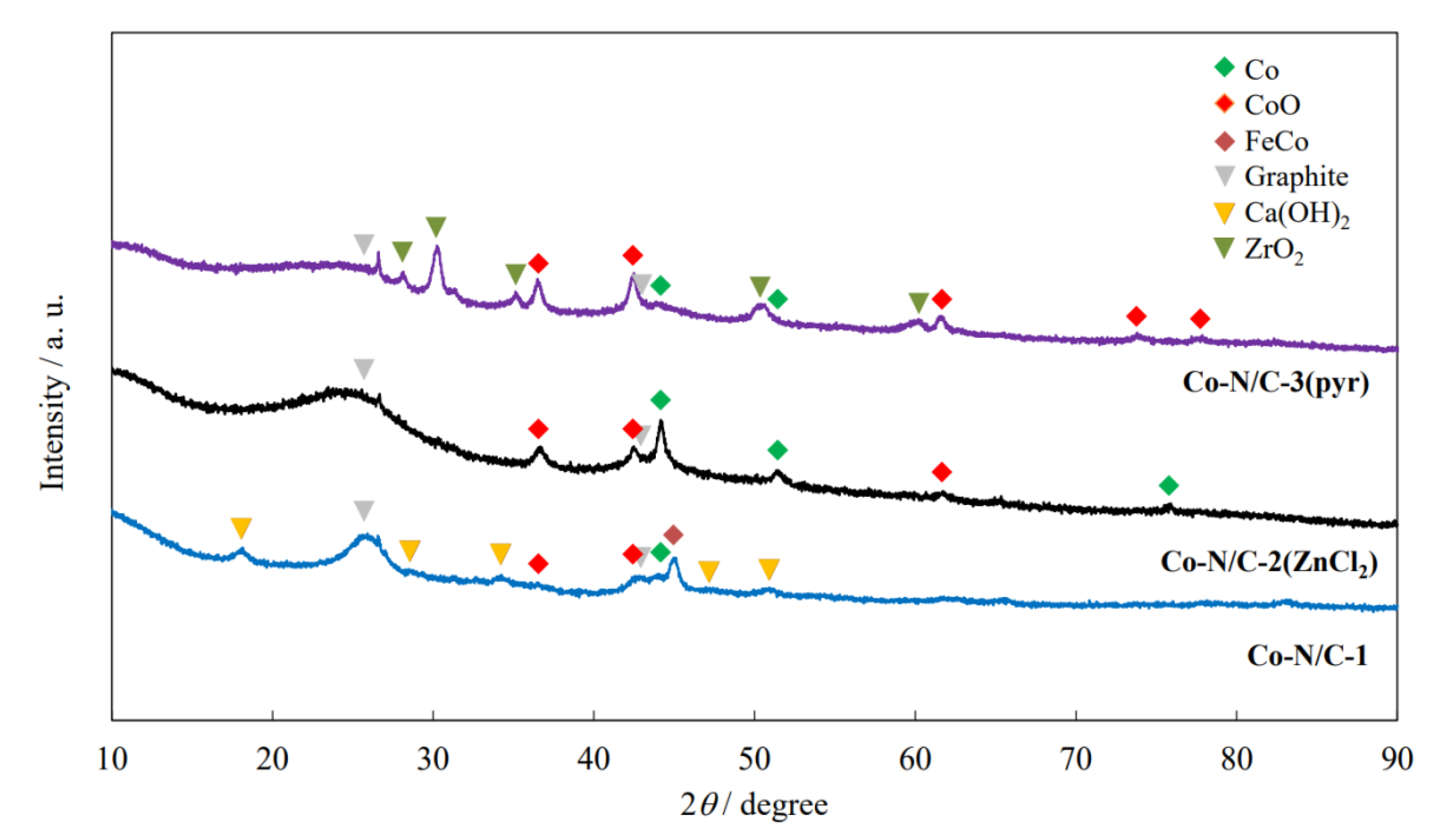
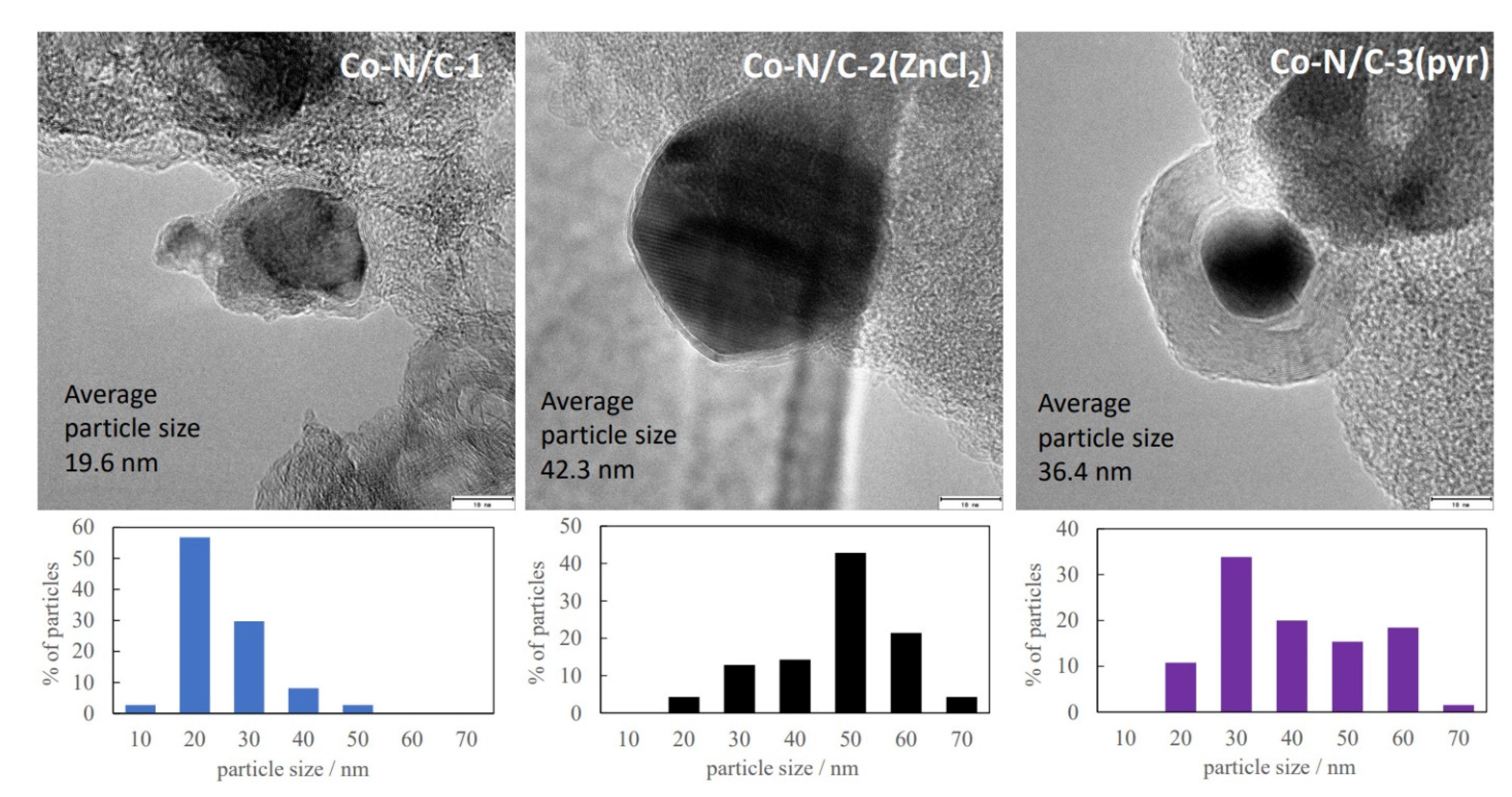
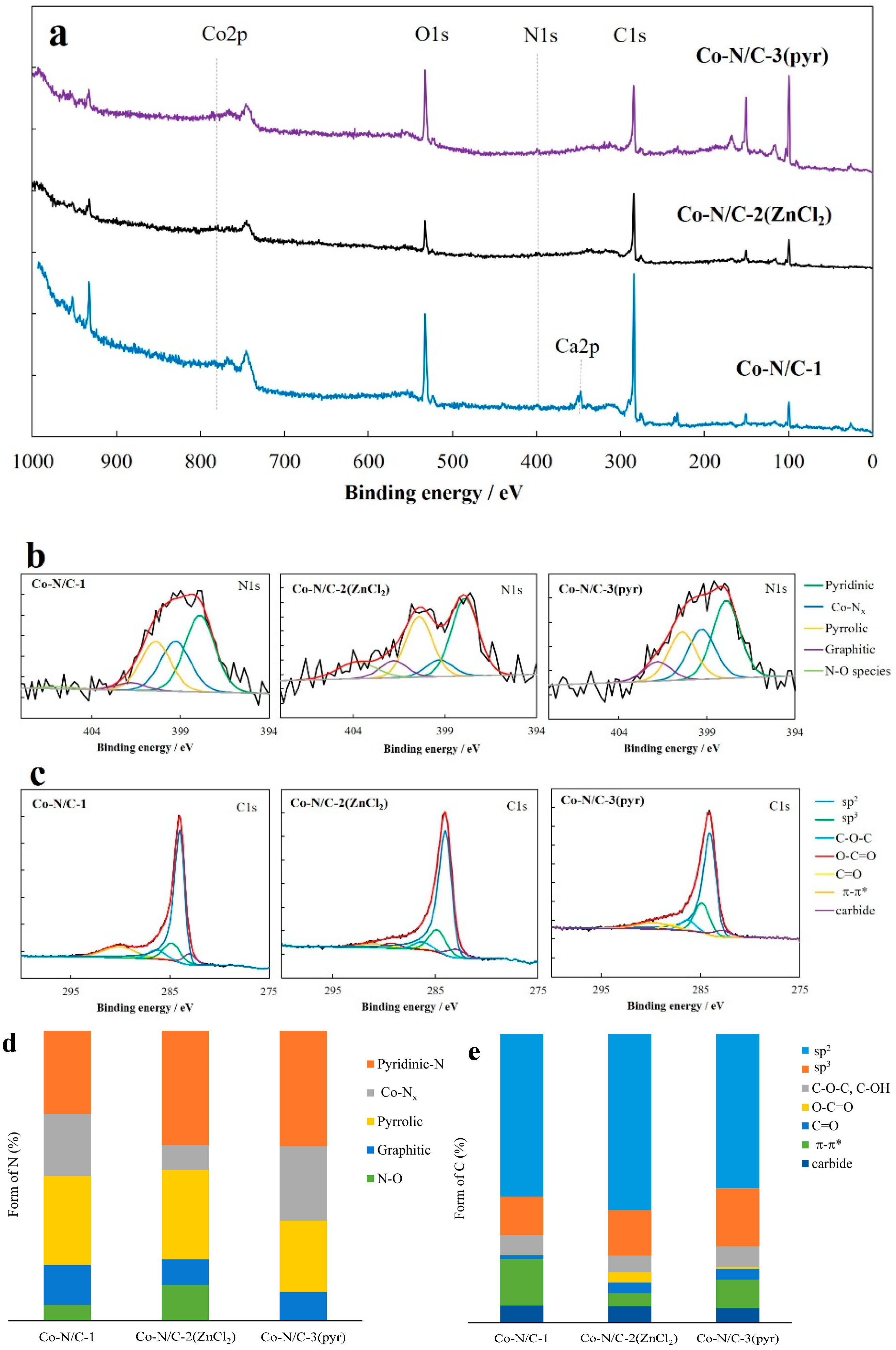
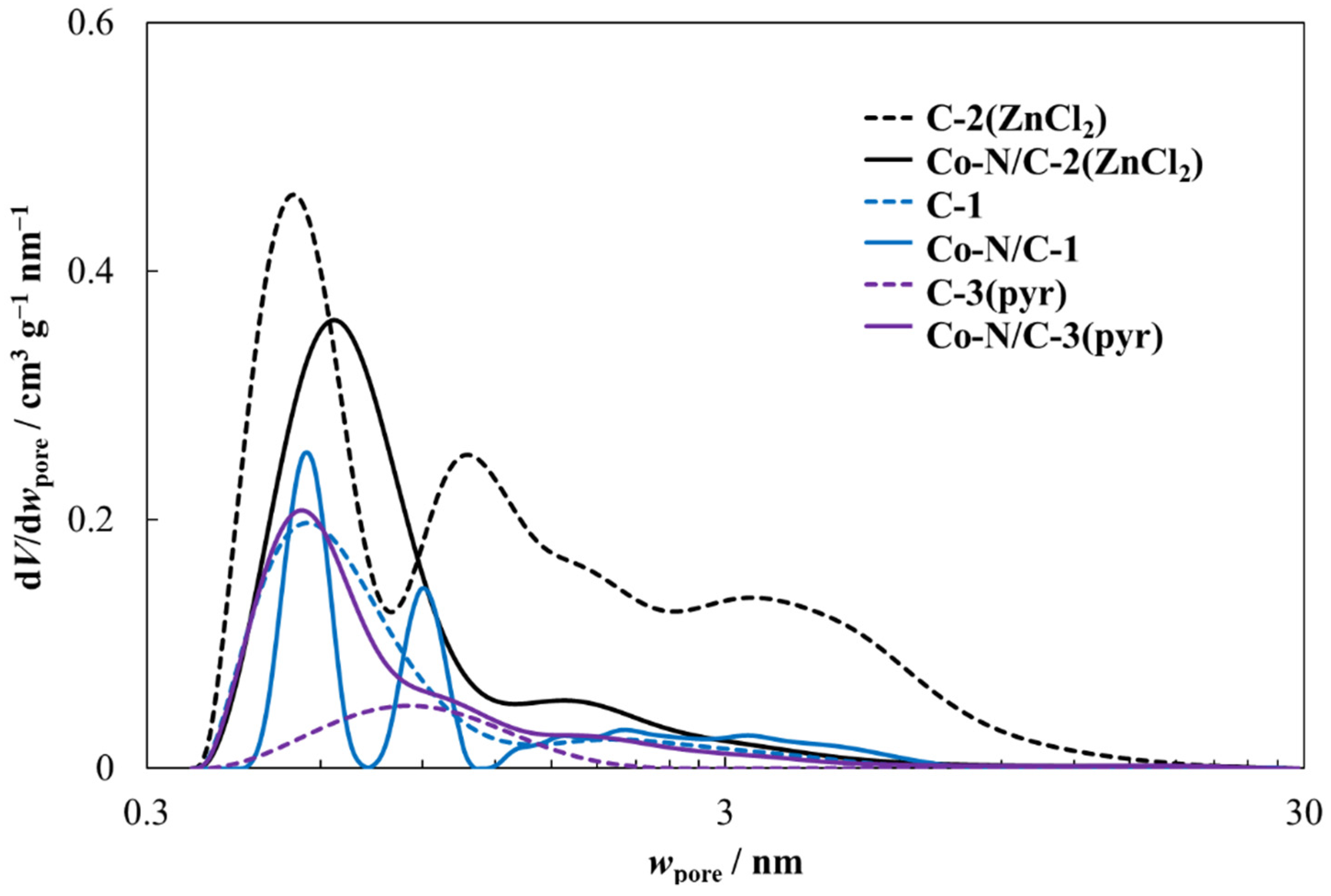
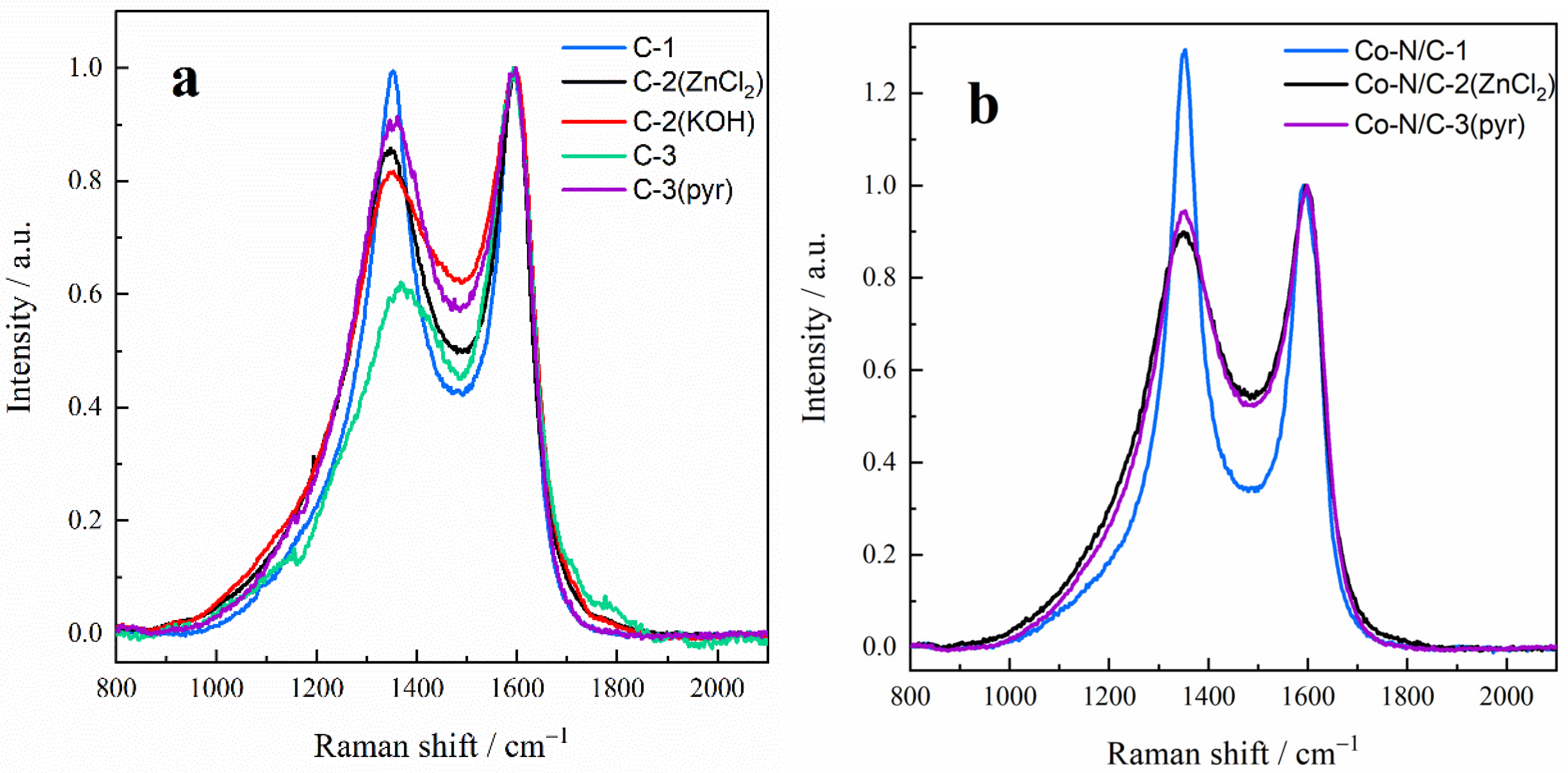

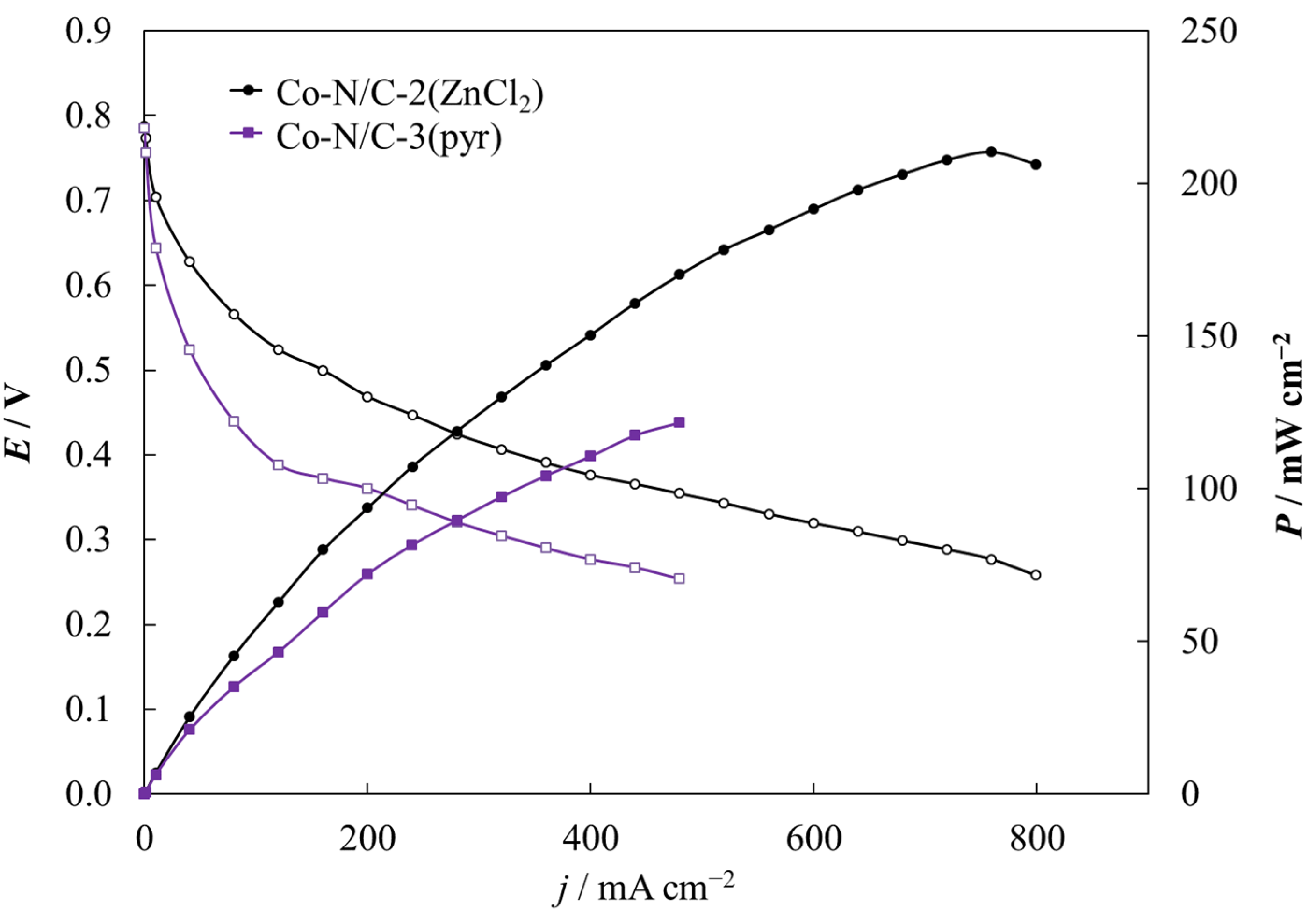
| Material | C | O | N | Ca | Co | Other Elements (<1 wt%) |
|---|---|---|---|---|---|---|
| C-1 | 68.33 | 8.87 | - | 18.27 | - | Si, S, Fe, Mg, Al, Cl, P, Na |
| C-2(KOH) | 83.41 | 9.80 | 5.68 | - | - | Si, S, Cl, Al |
| C-2(ZnCl2) | 84.56 | 11.10 | 2.49 | - | - | Si, S, Al |
| C-3 | 76.78 | 17.04 | 5.49 | - | - | Si, S |
| C-3(pyr) | 96.44 | 2.77 | - | 0.31 | - | Si, S |
| Co-N/C-1 | 67.98 | 14.77 | 2.80 | 8.36 | 3.07 | Si, S, Mg, Al, Cl |
| Co-N/C-2(KOH) | 83.92 | 6.19 | 5.75 | - | 2.97 | Si, Cl |
| Co-N/C-2(ZnCl2) | 74.00 | 13.84 | 3.36 | - | 5.93 | Al, Cl, S |
| Co-N/C-3 | 78.25 | 11.28 | 5.54 | - | 4.61 | Si, Al |
| Co-N/C-3(pyr) | 80.93 | 9.71 | 4.11 | - | 3.59 | Si, Al, Cl |
| Material | C (at%) | O (at%) | N (at%) | Ca (at%) |
|---|---|---|---|---|
| Co-N/C-1 | 70.94 | 20.89 | 1.51 | 6.66 |
| Co-N/C-2(ZnCl2) | 82.98 | 14.64 | 2.36 | - |
| Co-N/C-3(pyr) | 70.60 | 27.29 | 2.11 | - |
| Material | SBET (m2 g−1) | SDFT (m2 g−1) | Vtot (cm3 g−1) | VDFT (cm3 g−1) | Sµ (m2 g−1) | Vµ (cm3 g−1) |
|---|---|---|---|---|---|---|
| C-1 | 270 | 304 | 0.16 | 0.15 | 130 | 0.06 |
| C-2(ZnCl2) | 1270 | 1110 | 1.14 | 1.11 | 200 | 0.08 |
| C-3(pyr) | 90 | 89 | 0.03 | 0.05 | 80 | 0.02 |
| Co-N/C-1 | 246 | 241 | 0.24 | 0.18 | 48 | 0.02 |
| Co-N/C-2(ZnCl2) | 520 | 550 | 0.31 | 0.30 | 250 | 0.11 |
| Co-N/C-3(pyr) | 273 | 301 | 0.18 | 0.17 | 135 | 0.06 |
| ID/IG | G Peak Width (FWHM, cm−1) | D Peak Width (FWHM, cm−1) | |
|---|---|---|---|
| C-1 | 0.99 | 71.3 | 105.3 |
| C-2(KOH) | 0.81 | 77.2 | 180.2 |
| C-2(ZnCl2) | 0.86 | 74.5 | 187.1 |
| C-3 | 0.61 | 86.1 | 239.0 |
| C-3(pyr) | 0.9 | 74.5 | 207.5 |
| Co-N/C-1 | 1.29 | 66.0 | 73.4 |
| Co-N/C-2 (ZnCl2) | 0.90 | 64.8 | 191.8 |
| Co-N/C-3(pyr) | 0.94 | 72.8 | 157.5 |
Publisher’s Note: MDPI stays neutral with regard to jurisdictional claims in published maps and institutional affiliations. |
© 2021 by the authors. Licensee MDPI, Basel, Switzerland. This article is an open access article distributed under the terms and conditions of the Creative Commons Attribution (CC BY) license (https://creativecommons.org/licenses/by/4.0/).
Share and Cite
Jäger, R.; Teppor, P.; Paalo, M.; Härmas, M.; Adamson, A.; Volobujeva, O.; Härk, E.; Kochovski, Z.; Romann, T.; Härmas, R.; et al. Synthesis and Characterization of Cobalt and Nitrogen Co-Doped Peat-Derived Carbon Catalysts for Oxygen Reduction in Acidic Media. Catalysts 2021, 11, 715. https://doi.org/10.3390/catal11060715
Jäger R, Teppor P, Paalo M, Härmas M, Adamson A, Volobujeva O, Härk E, Kochovski Z, Romann T, Härmas R, et al. Synthesis and Characterization of Cobalt and Nitrogen Co-Doped Peat-Derived Carbon Catalysts for Oxygen Reduction in Acidic Media. Catalysts. 2021; 11(6):715. https://doi.org/10.3390/catal11060715
Chicago/Turabian StyleJäger, Rutha, Patrick Teppor, Maarja Paalo, Meelis Härmas, Anu Adamson, Olga Volobujeva, Eneli Härk, Zdravko Kochovski, Tavo Romann, Riinu Härmas, and et al. 2021. "Synthesis and Characterization of Cobalt and Nitrogen Co-Doped Peat-Derived Carbon Catalysts for Oxygen Reduction in Acidic Media" Catalysts 11, no. 6: 715. https://doi.org/10.3390/catal11060715







